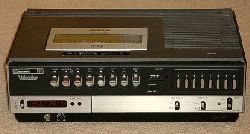The VCR Is Dead

The videocassette recorder got its start with the Sony U-Matic in 1971. That 3/4-inch format found limited pro uses. But for consumers, the first widely adopted VCR format was the Sony Betamax, first in sold in 1975. When Matsushita's VHS arrived the following year, a format war ensued, with VHS emerging as the victor.
Legal battles ensued. The VCR inspired two Supreme Court decisions that lay the groundwork for consumer video products. One was the 1984 Betamax Decision, in which Disney sued Sony for enabling copyright violation, but was rebuffed, with the court instead sanctioning home video recording for time-shifting and personal use. In another case the high court upheld the First Sale Doctrine, which allowed video rental stores to buy and rent movies and other material on videocassette.
DVD made its U.S. debut in 1997 and eclipsed VHS as the prime rental format by 2003. The standard-def disc was the result of an unprecedented peace agreement that pooled technologies from Toshiba and Matsushita with those from Sony and Philips. Unfortunately, the massive success of DVD didn't prevent subsequent format wars between DVD-Audio vs. SACD (with disastrous results for both) and HD DVD vs. Blu-ray. In the latter, Blu-ray was the victor, but it remains to be seen whether the high-def disc will enjoy the success of VHS and DVD.
- Log in or register to post comments





























































